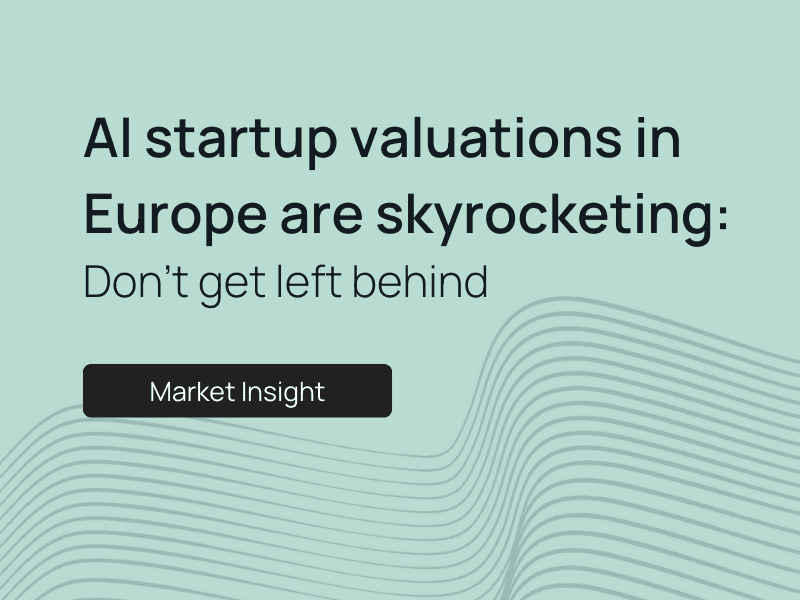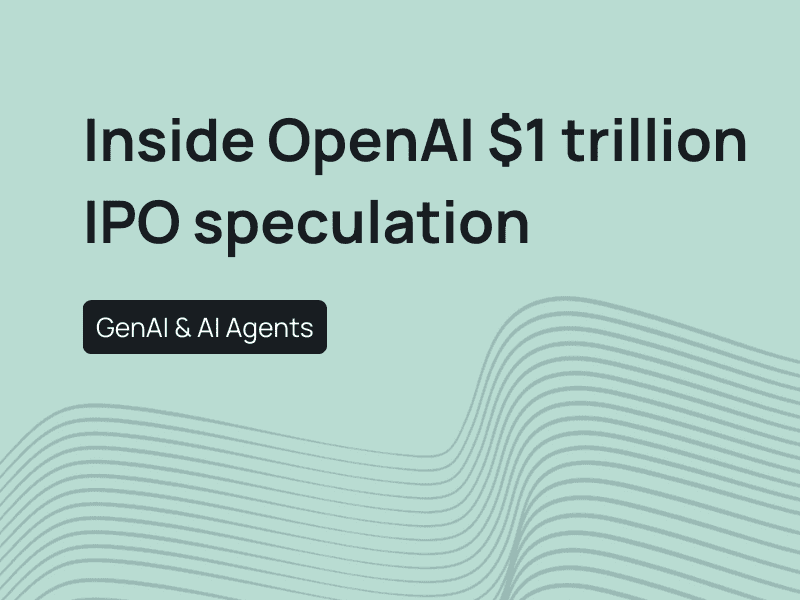Mistral AI has quickly emerged as one of Europe’s most important AI startups, positioning itself as a counterweight to U.S. giants like OpenAI and Anthropic. Founded by alumni from DeepMind, Meta, and Google, the company has attracted outsized funding and attention by pursuing a distinctive strategy: building powerful open-weight models that balance cutting-edge performance with transparency and accessibility. While most headlines in AI are dominated by closed, proprietary systems, Mistral’s approach taps into growing demand for customizable, sovereign, and cost-efficient alternatives.
Funding milestones
Mistral AI has had one of Europe’s fastest-growing funding trajectories, starting with a €105 million seed round in June 2023 and reaching a valuation of nearly $14 billion by late 2025. Along the way, it closed a €385 million Series A (Dec 2023, €2 billion valuation), a Series B in mid-2024 (raising €468–600 million, valuing it at €5.8 billion), a €1.7 billion Series C in Sept 2025 (valuation at €11.7 billion), and finally a €2 billion mega-round that more than doubled its value. By comparison, Anthropic recently raised $13 billion at a post-money valuation of $183 billion, while OpenAI is reportedly valued in the hundreds of billions, with a recent round suggesting a $300 billion valuation and some internal talks pushing toward $500 billion. This places Mistral at a much smaller absolute scale, but with one of the steepest growth curves in Europe and a valuation multiple trajectory that is becoming increasingly comparable in context.
Technology & product strategy
A characteristic element of Mistral AI’s strategy is its commitment to open-weight models, setting it apart from closed-source competitors like OpenAI and Anthropic. Rather than locking models behind proprietary APIs, Mistral releases versions that can be openly accessed, modified, and deployed, enabling enterprises, researchers, and developers to build with greater transparency and flexibility. This approach not only accelerates adoption across industries but also strengthens trust by allowing users to scrutinize performance, biases, and security risks. While closed-source models often prioritize monetization and control, Mistral’s open-weight philosophy positions it as a democratizing force in AI—lowering barriers to entry, fostering innovation in Europe’s ecosystem, and appealing to enterprises seeking more control over their infrastructure.
Infrastructure partnerships
Mistral AI has built a strong network of infrastructure partnerships to support its fast growth. On the hardware side, it works with Nvidia to secure access to the GPUs needed to train and run large models. Its recent funding also brought in ASML, tying the company more closely to Europe’s semiconductor ecosystem. In the cloud, Mistral partners with providers like Microsoft Azure, giving it global scale while still developing EU-focused collaborations to keep key resources closer to home. These partnerships give Mistral the compute power, cloud access, and regional support it needs to expand quickly while positioning itself as a leading European alternative to U.S. players.
Differentiators
Transparency - Mistral’s open-weight models, including Mistral 7B and Mixtral-8x7B, are freely available under permissive licenses on platforms like Hugging Face, allowing developers and enterprises to inspect, customize, and deploy them independently. This open approach has driven millions of downloads within months of release, reinforcing trust and reducing reliance on black-box systems like OpenAI’s GPT models.
Adaptability - Mistral’s models are already being adapted for diverse industries. For example, IBM integrated Mixtral-8x7B into its watsonx.ai platform to improve latency by up to 75%, while France Travail deployed Mistral technology to enhance public employment services used by 10,000 agents. This flexibility demonstrates how open-weight architectures can be fine-tuned to specific operational and sectoral needs.
Developer community focus - Within months of launch, Mistral’s open models have generated one of the fastest-growing developer communities in Europe, with thousands of active contributors on GitHub and Hugging Face. Frequent updates, community-driven fine-tuning, and collaborative model evaluations have created a self-sustaining ecosystem that accelerates innovation and adoption.
European sovereignty angle - By keeping core operations, R&D, and data infrastructure within Europe, Mistral aligns closely with EU digital sovereignty objectives. The company’s partnerships with the Luxembourg government on sovereign AI infrastructure and its AI Factory initiative with CMA CGM underscore its role as a trusted European alternative to U.S. tech giants, appealing to both public and private sectors seeking local control and regulatory alignment.
Scalability & flexibility - Mistral’s infrastructure partnerships with Microsoft Azure, Nvidia, and major European data centers enable scalable cloud and edge deployment while maintaining operational flexibility. These collaborations allow enterprises to balance cost, performance, and compliance—key factors in scaling AI solutions sustainably across markets.
Market positioning
Mistral AI is positioned as Europe’s flagship AI champion, offering a homegrown alternative to U.S. giants like OpenAI, Anthropic, and Meta. The company focuses on enterprises and government organizations that require transparent, customizable, and controllable AI solutions, giving it a strategic edge in sectors where trust and regulatory compliance are critical. Beyond serving end users, Mistral also acts as an anchor for Europe’s broader AI ecosystem, fostering collaboration with startups, developers, and corporate partners. Its combination of open-weight models, adaptability, and European infrastructure partnerships reinforces a defensible market position and distinguishes it from closed-source competitors.
Business model & competitive landscape
Business model
Licensing - Enterprises can directly integrate Mistral’s open-weight models into their products and workflows, generating upfront revenue.
Enterprise services - Custom model training, deployment support, and consulting provide higher-margin, service-based income.
Cloud deployment - Scalable, cloud-based offerings create recurring revenue through subscription or usage-based models.
Hybrid approach - Combining licensing, services, and cloud solutions allows Mistral to diversify its revenue streams and support sustainable growth.
Strategic advantage - Monetization aligns with Europe’s demand for transparent, controllable AI, reinforcing the company’s differentiation from U.S. closed-source providers.
Mistral AI’s open-weight models are central to driving adoption, offering enterprises and developers the flexibility to integrate, modify, and deploy advanced AI solutions in ways that suit their specific needs. Beyond the models themselves, the company generates revenue through paid support and customization services, helping clients optimize performance, adapt models to unique workflows, and ensure reliable deployment. This combination of openness and tailored services not only accelerates adoption but also creates a scalable path to monetization, allowing Mistral to capture value from both widespread use and premium enterprise offerings. By pairing accessible models with hands-on support, the company strengthens customer relationships while building a sustainable business foundation.
Competitive landscape
OpenAI - OpenAI remains the global benchmark leader, with GPT-5 setting the highest performance across domains like coding, reasoning, and mathematics—scoring roughly 26–28% on the FrontierMath benchmark. However, OpenAI’s fully closed-source approach limits flexibility and transparency, leaving enterprises with few options to customize or locally deploy models—an area where Mistral’s open-weight strategy directly appeals to compliance-sensitive sectors in Europe.
Anthropic - Anthropic’s Claude 3.7 and Opus models emphasize safety, reasoning, and large-context capabilities (performing around 12–14% on FrontierMath). While strong in alignment and ethical AI, Anthropic remains a closed, API-based ecosystem. Mistral’s comparable reasoning quality on internal multilingual and logic benchmarks—combined with open deployment—offers enterprises similar capabilities without vendor lock-in.
Google (Gemini) - Gemini 2.5 Pro delivers strong multimodal reasoning but remains tightly integrated into Google’s proprietary cloud stack. Mistral, by contrast, partners with multiple cloud providers (including Azure, OVHcloud, and Scaleway) and can run efficiently on-premise or at the edge, offering flexibility in cost and deployment architecture that hyperscalers typically can’t match.
Meta (LLaMA) - Meta’s LLaMA models, while open-weight, are geared toward research rather than commercial use. They lack dedicated enterprise support or infrastructure integrations. Mistral bridges this gap—offering both openness and enterprise readiness, demonstrated by its integrations with IBM Watsonx, Snowflake, and public-sector deployments across France and Luxembourg.
Cohere - Focused on language understanding and enterprise APIs, Cohere excels in English NLP but offers less adaptability across languages and sectors. Mistral’s models, trained natively on multilingual corpora, perform competitively across English, French, and German benchmarks, giving it an advantage in European markets where linguistic diversity matters.
Mistral’s Edge - While Mistral’s current open models (e.g., Mixtral-8x7B) trail GPT-5 on raw benchmark scores, they deliver 80–90% of top-tier performance at a fraction of the cost and latency, according to independent tests by MLPerf and Hugging Face. Its open-weight architecture, efficient inference design, and strong European ecosystem support give it a defensible niche: flexible, high-performance AI that enterprises can own, customize, and deploy under sovereign control.
Risks & opportunities
Risks - Mistral AI faces a few key risks that investors should keep in mind. The company competes with well-funded U.S. players like OpenAI, Anthropic, and Cohere, which can make it harder to gain market share and attract top talent. Keeping skilled researchers in Europe is also a challenge, as many are drawn to larger tech firms abroad. Its open-weight approach, while innovative, could limit revenue opportunities compared with proprietary models. European regulations like the EU AI Act add complexity and compliance costs, which may slow growth. Managing these risks will be critical as Mistral scales.
Opportunities - Mistral AI has several promising opportunities to drive growth and create value, backed by tangible traction across both the public and private sectors. There is a growing demand for European alternatives to U.S.-dominated AI players—particularly among enterprises and governments that prioritize control, transparency, and compliance—Mistral has positioned itself at the center of Europe’s push for digital sovereignty. Supported by EU institutions and national governments, the company has secured major contracts, including a multi-year partnership with the Luxembourg government to establish a sovereign AI R&D hub, and deployment of its models in France Travail’s job-matching system, used by nearly 10,000 public agents. In the private sector, Mistral’s open-weight models are being integrated by global corporations: IBM’s Watsonx platform uses Mixtral-8x7B to reduce inference latency by up to 75%, while Snowflake employs Mistral’s technology to improve text-to-SQL accuracy in its Cortex Analyst product. A €100 million, five-year alliance with logistics leader CMA CGM has also led to the creation of a “Mistral AI Factory” in Marseille, embedding its AI into operational workflows. These partnerships, combined with ASML’s €1.3 billion investment in its €1.7 billion Series C and continued support from Nvidia and European governments, underscore Mistral’s growing role as Europe’s AI flagship—offering customizable, transparent, and efficient AI solutions designed for scalable, sustainable deployment across industries.
The bottom line
Mistral AI has quickly emerged as Europe’s flagship AI contender, combining open-weight innovation with deep infrastructure and enterprise partnerships. Its transparent, adaptable approach positions it as a credible alternative to U.S. incumbents, while its funding trajectory underscores strong investor conviction.
For enterprises, Mistral offers practical advantages—customizable models, lower dependency on black-box providers, and alignment with Europe’s regulatory landscape. It represents a high-growth platform with both defensibility and scalability, capable of reshaping how AI is adopted across industries.
Published by Samuel Hieber


